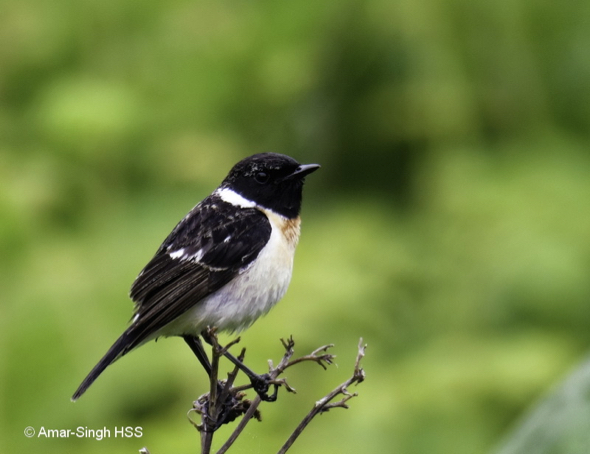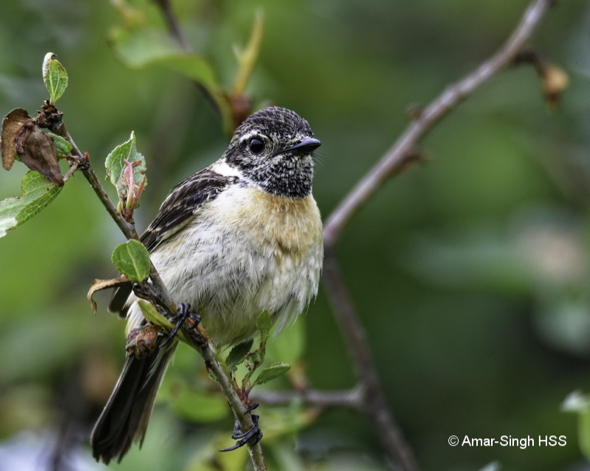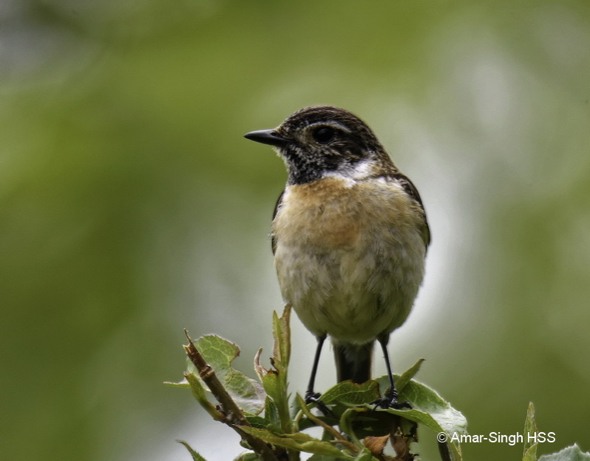“I have been trying to make sense of the breeding adults we saw while in Hokkaido. Clement (2015) provides extensive descriptions of ‘Common’ Stonechats and the subspecies, including Stejneger’s Stonechat. Opaev & colleagues (2018) say ‘S. stejnegeri is a cryptic species as it cannot be distinguished by morphometrics and by worn spring plumage from S. maurus, but differs noticeably by male song.’
“The adult breeding males are unmistakable with a very dark head and neck (a blotchy supercilium), dark upperparts and varying degrees of orange on the breast (especially bright on the upper breast). Two examples are shown above and below.
“The adult breeding females are more variable. They have paler upper parts (more brown cf males), a clear supercilium, some orange on the upper breast (not as strong as males) and the expectation is that the throat is lighter. Most of the birds we see when on migration are like this (paler) but we saw some darker females in Hokkaido.
Images above and below are of two adult breeding females (assumed from nest feeding behaviour and presence of a feeding male companion). The bird above was the companion of the bird above this image (we saw this pair at least 3 different times at the entrance to a forest and they were feeding young).
“Some would say that these are breeding first/second year males but there was already a mature adult male in attendance. Clement (2015) does not mention any evidence of male nest helpers. Handbook of the Birds of the World (2019) states ‘Male very occasionally pairs with two females‘.
“I would appreciate opinions.”
Dato’ Dr Amar-Singh HSS
Ipoh, Perak, Malaysia
5-10th June 2019
Location: East Hokkaido, Japan
References:
1. Peter Clement, Chris Rose, Robins and Chats, Helm Identification Guides 2015
2. Mark Brazil. Birds of Japan. Helm Field Guides 2018
3. Collar, N. (2019). Common Stonechat (Saxicola torquatus). In: del Hoyo, J., Elliott, A., Sargatal, J., Christie, D.A. & de Juana, E. (eds.). Handbook of the Birds of the World Alive. Lynx Edicions
4. Alexey Opaev, Yaroslav Red’kin, Egor Kalinin & Maria Golovina. Species limits in Northern Eurasian taxa of the common stonechats, Saxicola torquatus complex (Aves: Passeriformes, Muscicapidae). Vertebrate Zoology. 2018, 68 (3): 199 – 211.
5. Ewan Urquhart & Adam Bowley. Stonechats. Helm Identification Guides 2002.












